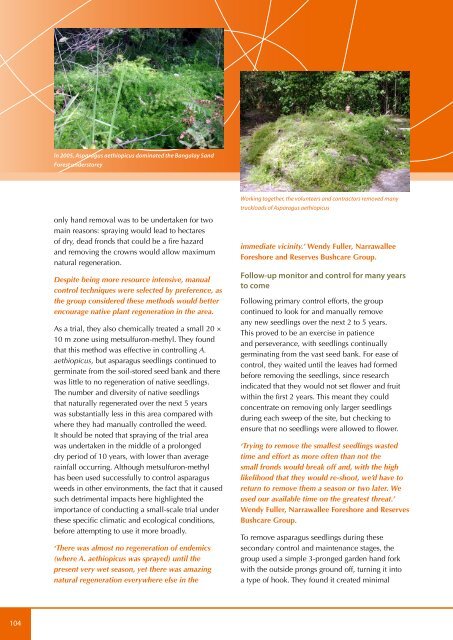Asparagus weeds - Weeds Australia
Asparagus weeds - Weeds Australia
Asparagus weeds - Weeds Australia
- No tags were found...
You also want an ePaper? Increase the reach of your titles
YUMPU automatically turns print PDFs into web optimized ePapers that Google loves.
In 2005, <strong>Asparagus</strong> aethiopicus dominated the Bangalay SandForest understoreyonly hand removal was to be undertaken for twomain reasons: spraying would lead to hectaresof dry, dead fronds that could be a fire hazardand removing the crowns would allow maximumnatural regeneration.Despite being more resource intensive, manualcontrol techniques were selected by preference, asthe group considered these methods would betterencourage native plant regeneration in the area.As a trial, they also chemically treated a small 20 ×10 m zone using metsulfuron-methyl. They foundthat this method was effective in controlling A.aethiopicus, but asparagus seedlings continued togerminate from the soil-stored seed bank and therewas little to no regeneration of native seedlings.The number and diversity of native seedlingsthat naturally regenerated over the next 5 yearswas substantially less in this area compared withwhere they had manually controlled the weed.It should be noted that spraying of the trial areawas undertaken in the middle of a prolongeddry period of 10 years, with lower than averagerainfall occurring. Although metsulfuron-methylhas been used successfully to control asparagus<strong>weeds</strong> in other environments, the fact that it causedsuch detrimental impacts here highlighted theimportance of conducting a small-scale trial underthese specific climatic and ecological conditions,before attempting to use it more broadly.‘There was almost no regeneration of endemics(where A. aethiopicus was sprayed) until thepresent very wet season, yet there was amazingnatural regeneration everywhere else in theWorking together, the volunteers and contractors removed manytruckloads of <strong>Asparagus</strong> aethiopicusimmediate vicinity.’ Wendy Fuller, NarrawalleeForeshore and Reserves Bushcare Group.Follow-up monitor and control for many yearsto comeFollowing primary control efforts, the groupcontinued to look for and manually removeany new seedlings over the next 2 to 5 years.This proved to be an exercise in patienceand perseverance, with seedlings continuallygerminating from the vast seed bank. For ease ofcontrol, they waited until the leaves had formedbefore removing the seedlings, since researchindicated that they would not set flower and fruitwithin the first 2 years. This meant they couldconcentrate on removing only larger seedlingsduring each sweep of the site, but checking toensure that no seedlings were allowed to flower.‘Trying to remove the smallest seedlings wastedtime and effort as more often than not thesmall fronds would break off and, with the highlikelihood that they would re-shoot, we’d have toreturn to remove them a season or two later. Weused our available time on the greatest threat.’Wendy Fuller, Narrawallee Foreshore and ReservesBushcare Group.To remove asparagus seedlings during thesesecondary control and maintenance stages, thegroup used a simple 3-pronged garden hand forkwith the outside prongs ground off, turning it intoa type of hook. They found it created minimal104
















